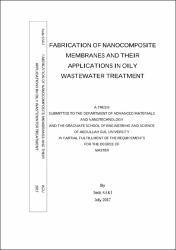| dc.description.abstract | Industrial oily wastewaters are generated by various industries such as steel, food, textile, leather, petrochemical and metal milling and should be treated before discharging natural environment due to its serious environmental problems. With this view, membrane separation processes have promote a significant development of novel and green technology for oily wastewater treatment due to its clear advantages, for instance, ease in operation, efficient separation, low energy consumption and cost. Specially microfiltration (MF) and ultrafiltration (UF) membranes are playing a more prominent role in the oily wastewater treatments because of many advantages like as stable effluent quality, small area requirement, no chemicals addition, high chemical oxygen demand (COD) removal and low energy need. But the main drawback of membrane processes is the fouling problem. To overcome this problem, many researchers effort fabrication of high performance of membrane with higher hydrophilicity and antifouling properties. In this study, flat-sheet PSF/PEI nanocomposite membranes using Al2O3 and CaCO3 nanoparticles were prepared by phase inversion method. The effect of Al2O3 and CaCO3 nanoparticles were investigated on the structural properties and filtration performance of the nanocomposite membranes. Prepared membranes were characterized with scanning electron microscopy (SEM), fourier transform infrared spectroscopy (FT-IR), contact angle, porosity, water flux, thermogravimetric analysis (TGA), atomic force microscope
ii
(AFM), X-ray diffraction (XRD), BSA rejection, tensile strength, and viscosity measurements. Membrane permeability performance and antifouling properties towards oil water emulsion separation of these new generation nanocomposite membranes were evaluated for synthetic and real industrial oily wastewater. The results showed that there is a great potential to use these nanocomposite membranes for oily water treatment with higher permeability and antifouling capacity. All Al2O3 and CaCO3 nanocomposite membranes reached higher oil rejection ratios over 90%. | en_US |


















